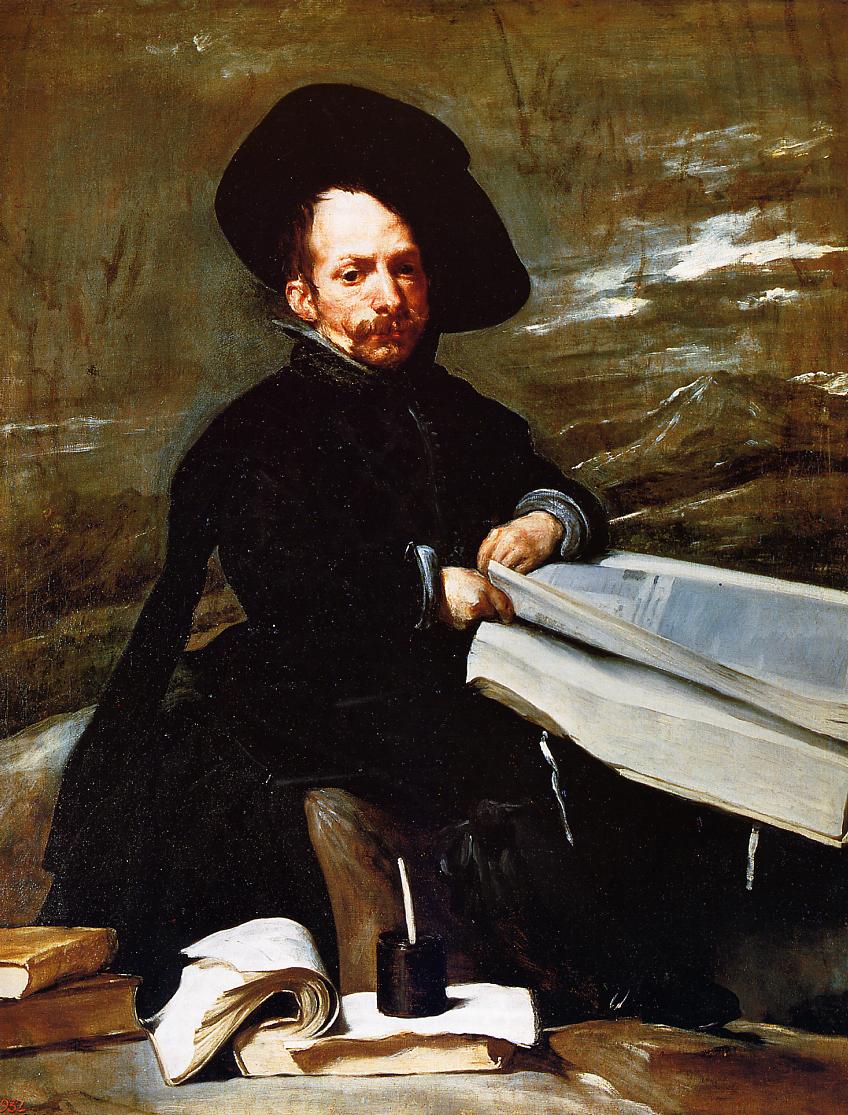Hy classmates!
Today in the Social Sciences class Paqui has asked if we had brought the book of 4º ESO and she has sayed that we have to bring it next Friday.
Then she has showed us some publications that she had posted previously on the blog. She has explained us the "Pentimenti": Velázquez wanted to make perfect paintings, so he retouched his paintings many times and we can discovered this because as time goes by, the oil mixed with linseed oxidizes and parts of the painting covered by the painter become visible and we can observe what the creative process of the painter was like. Paqui has showed us some examples about pentimenti:
-Jester Calabacillas: We can observe that the form of the pumpin has changed.

Source: http://0.tqn.com/d/arte/1/0/I/3/-/-/Velazquez-bufon-calabacillas.jpg
(Paqui's publication)
-Don Diego de Acedo : We can observe that there are some black spins due to that Velázquez cleaned the brush in the background of the painting.

Source: (Paqui's publication)
-Philip IV on horseback: We can see that the position of the legs of the horse has been retouched and actually we can see 6 legs.

Later, Paqui has showed us the publication about " The Spinners" . In this painting we can observe that the nain scene is in the background in the tapestry , where it's represented The Fable of Arachne ( Athena is punishing Arachne).

Source: Paqui's publication.
Afterwards she has showed us a web where you can see the painting "Las Meninas" in 3D. It's very interesting and you can see the king with the queen behind the scene and they are reflected in a mirror. In the painting appears the Infant Margarita and its atendants, two jesters, the nun, some tutors and a nobleman opening the door. Velázquez retouched this painting after to paint the cross on his chest.

Source: Maria's publication.
Then we have reviewed some of the contents for tomorrow ( terrible exam!!):
Paqui has asked us about the reigns of Philip IV and Philip III ( internal problems and problems in Europe ). We have reviewed also the absolute monarchy with Louis XIV , the English Revolutions, the reigns of Charles I , Philip II and Diego Velázquez (beginnings in Seville, he met Rubens, he travelled twice to Italy..)
Paqui has recommended us to read Alatriste's books , Alatriste died in the Battle of Rocroi(1643) where the Spanish army was defeated by the French Army. He also has recommended us to watch the film: Letters from Iwojima where many soldiers died ( 40,000). Finally Paqui has asked us some artists of Renaissance and Baroque Art and we have had to say some works about these artists.
For me the most difficult thing is the art (Renaissance and Baroque art , also in the Hispanic Kingdom) because there are a lot of artists and works. We haven't reviewed the demography, society and economy in the 17th century , the colonization , administration and conquest of the Indies, the Baroque art in the Hispanic Kingdom , the Scientific Revolution...
Here you have a video about the Battle of Rocroi (Alatriste's film):
We have also learned some new words:
-stain: mancha
-linseed: linaza
-oil: óleo
-to oxidize: oxidarse
-Athena: Atenea
-Truce: Tregua
Finally the bell has rung and we have gone out!
Hello María:
ReplyDeletePlease, be careful with grammar:
-She has said: Revise irregular verbs
- We can discover : After “can” you always write the infinitive
- pumpkin
- We can observe that there are some black spins due to the fact that Velázquez
- that the main scene is in the background in the tapestry , The Fable of Arachne is represented
- In the painting we can see the Infant Margarita
- Velázquez retouched this painting after painting : After a preposition, you ALWAYS write an –ing
- She has also recommended
Thanks Cristina!
ReplyDeleteHello,
ReplyDeleteA little late, but here I am. Please, correct what Cristina told you. And these are my corrections about the content:
- we can observe that there are some black stains / lines
- The names of the paintings have to be in Italic font The Fable of Arachne and the same with works of art, names of books, films...
- The painting The Fable of Arachne wasn't painted by Velázquez, but by Titian first and later by Rubens. The fact that Velázquez included this painting in his work The Spinners is related to his desire to be recognized as an artist. In this way, he compared himself with other artists he admired.
- Afterwards she has showed us a website
- ...Infant Margarita and her attendants
- Velázquez retouched this painting later to paint
- You could write Philip IV and Philip III's reigns and the same with Charles I and Philip II's reigns
- Captain Alatriste's books. this fictitious character died in the Battle of Rocroi
- She has also recommended...
- Letters from Iwojima. You can add that we talked about this film because I explained how difficult invading an island is. We talked about this when we were reviewing about the failure of the Invincible Armada when they tried to invade England, during Philip II's reign. I told you that invading an island is extremely difficult, because you need a lot of soldiers. The same happened during WW2 with the invasion of many islands in the Pacific. Many soldiers died there. In the Battle of Iwojima, which lasted around one month, more than 26,000 soldiers died and there were more than 20,000 wounded and this island is very small. There are two films about this battle Flags of our fathers, which tells the story from the USA side, and Letters from Iwojima, which explains the battle from the Japanese side. Clint Eastwood is the director of both films. The second one is better in my opinion.
- Hispanic Kingdoms
That´s all. Please, correct and complete your journal Bye!